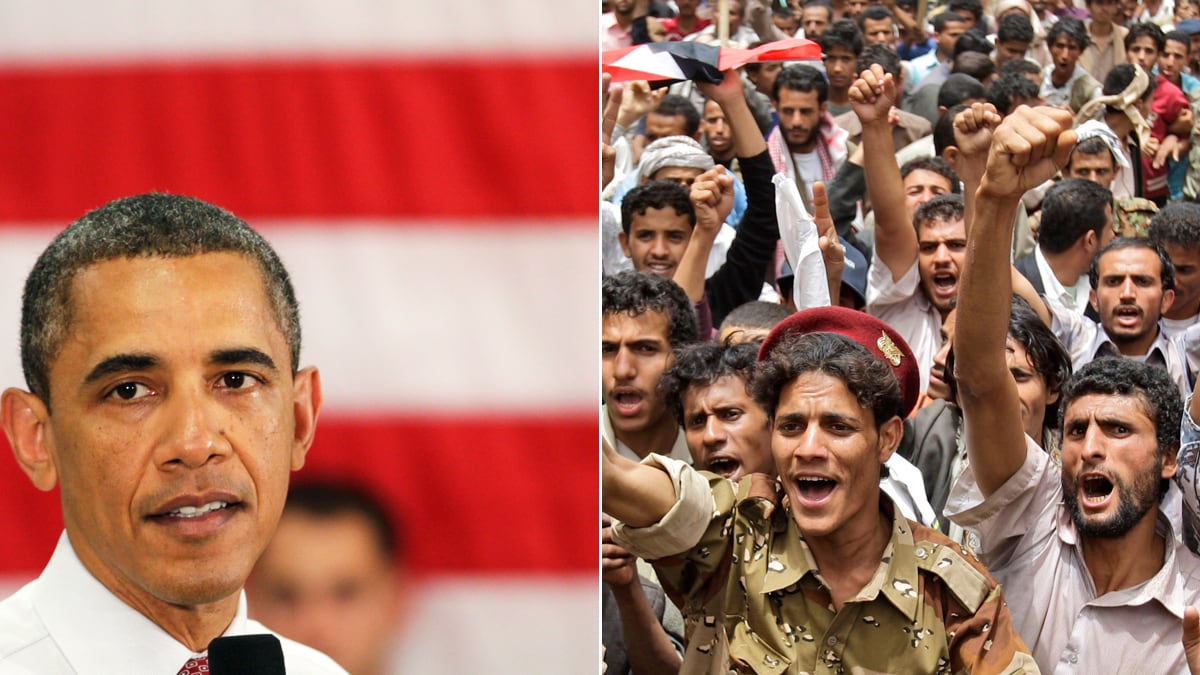The morning after President Barack Obama ordered a substantial and money-saving reduction of U.S forces in Afghanistan, his pointman in that conflict was already preparing for his next assignment: fostering a type of warfare that is mostly out of public view, far less costly and promises to reshape the way America fights.
“I wanted this job,” Gen. David Petraeus told the Senate Select Committee on Intelligence at his confirmation hearing to become CIA director last Thursday. “This is something that was not, you know, a month or two or three in the making,” Petraeus went on, explaining how he and soon-to-be-departing Defense Secretary Robert Gates “discussed this all the way back last year.”
As Petraeus sails toward becoming the nation's 22nd CIA chief, his carefully planned transition from four-star general to civilian intelligence boss likely foreshadows a larger transformation of U.S. warfare.
As America draws down its conventional military forces in Iraq and Afghanistan, it is increasingly fighting national security threats in places like Pakistan, Somalia, and Yemen through covert operations uniting Pentagon special forces, CIA paramilitary troops, and sophisticated drones, some that can launch powerful missiles while others are small enough to eavesdrop unnoticed in the shadows.

The goal is to disrupt terrorist plots and training facilities, thin out the terrorist ranks, and pre-empt insurgencies before they can escalate into threats to U.S. security.
Petraeus seems well-suited for the job. He already knows the consequences of letting such threats fester: He inherited the fraught task of quelling raging insurgencies in both Iraq and Afghanistan that had been allowed to spin out of control before his arrival. His approach–beginning with oversight of the crafting of the military's new counterinsurgency field manual in 2005-06–is widely credited with stabilizing both warfronts.
He compelled Army and Marines to set aside their mastery of high-intensity conventional warfare to learn the superhuman patience and contrarian skills of counterinsurgency. And he worked to orchestrate more effective collaboration between the military and the intelligence community.
Ironically, Petraeus discussed moving to the CIA for months with a boss who made the transition in reverse. Gates rose through the CIA to become director in the early 1990s before retiring from government service—only to be called back to the Pentagon at the end of 2006. As such, both men appreciate the power in harmonizing intelligence and military operations to combat 21st century threats, associates say. “As budgets draw down, we have no option but to learn to fight smarter with less,” Gates observed recently.
In persuading the president to send Petraeus to the CIA, Gates hopes, among other goals, to give the decorated general the institutional base from which he can nurture what promises to be a new sort of warfare.
A debate already rages in the war colleges and halls of Congress about the military's role in future counterinsurgencies. Cost figures loom large in these discussions. The campaign in Afghanistan is expected to cost $120 billion this year; at its peak in 2006 through 2008, the Iraq campaign cost roughly the same.
To a Pentagon confronting the inevitability of deep budget cuts, the number of troops needed to fight counterinsurgency campaigns and the ancillary requirements for ambitious civic reconstruction programs look increasingly unaffordable.
So there is growing interest in developing a second generation of counterinsurgency warfare. And the early lab is Yemen, where a covert war has raged for nearly three years against the terrorist group calling themselves al Qaeda in the Arabian Peninsula.
As sketched by participants, the campaign inside Yemen looks like this. Contingents of America’s “white” Special Operations Forces—the groups at Fort Bragg in North Carolina and the Rangers at Fort Benning in Georgia—are training Yemen’s own special forces.
Meanwhile, teams of “black” special forces—Delta Force, SEAL Team Six, and their helicopter-flying colleagues—are operating in the country in tandem with those trained Yemenis.
Operatives from the CIA’s paramilitary Special Activities Division are in-country running agents. The Pentagon's Joint Special Operations Command (JSOC), which runs the “black” special forces, is flying overhead an armada of drones, many of designs (and sizes) that are still classified.
The CIA, already flying a covert air force of Predator and Reaper drones over Pakistan, has now acquired enough that it’s begun patrols over Yemen to provide more consistent surveillance and heavier firepower than most of JSOC’s fleet can supply.
Meanwhile, a mini-carrier—currently the Marines’ amphibious assault vessel USS Boxer—is on permanent station in the Gulf of Aden off Yemen’s coast with a squadron of Harrier aircraft to fly strike-missions against targets in-country identified either by the CIA, special forces on the ground or the drones.
When the target warrants, the submarine escorting the amphib is called into action, to launch one of its battery of land-attack cruise missiles. In the command center of this covert campaign, video feeds from a drone over the target have allowed commanders to witness real-time the cruise missiles’ impact.
The campaign against al Qaeda in Yemen is thus far more ambitious than has been disclosed. No element in the campaign is new. What is new is their integration—CIA, “white” and “black” special operations forces, and conventional forces—into a unified effort under a single command.
The concept behind the operation took shape during Petraeus’ spell running Central Command from fall 2008 to mid-2010. After Petraeus shifted last summer to take over the effort in Afghanistan, the campaign was amped up by JSOC commander Vice Admiral William McRaven and Michael Vickers, the Pentagon’s Undersecretary for Intelligence (and a veteran of both U.S. Special Forces and the CIA’s Special Activities Division). At the CIA, Director Leon Panetta vigorously backed their efforts—which is one reason why Obama picked Panetta to succeed Gates.
Petraeus was likely referring very obliquely to the Yemen campaign when, at his confirmation hearing, he talked of the need to combat the network of al Qaeda “franchises”—the Yemen-based spinoff from Osama bin Laden by far the most threatening—with “networks of our own.”
“One of the major developments since 9/11 has been the establishment of this network, in many cases led by the Joint Special Operations Command of the military, but with very, very good partnering with elements of the Central Intelligence Agency, other elements of the intelligence community, and in fact with conventional military forces, the white SOF as well as the special mission units,” Petraeus told senators.
The focus of the Yemen campaign is counterterrorism. That’s the mission of the Joint Special Operations Command. But the integrating principle behind it has been applied in Pakistan and Afghanistan.
One reason the Pakistan military has tolerated the CIA’s rain of drone strikes against Afghan insurgents grouping in Pakistan is that, according to a knowledgeable source, the drones have saved Pakistani lives. In the Pakistan army’s big 2008 offensive into the rugged lands along its border with Afghanistan, special forces teams accompanied the advance, taking downloads on their laptops from CIA drones circling overhead to warn the lead Pakistani units of ambushes in waiting ahead of them. Despite worsening relations between Pakistan and Washington, information from drone surveillance is still being fed to the Pakistan military.
In Afghanistan, the combination of CIA-run assets and night raids by “black” special operations forces are reckoned to have decimated the ranks of the Taliban’s field commanders. Several thousand “white” special operations forces are, meanwhile, feverishly training up Afghan soldiers.
The conflict in Yemen is far from over—its future complicated now by the near civil war against the rule of President Ali Abdullah Saleh, who gave the go-ahead for the U.S. campaign against the al-Qaeda branch in his country.
But within the Pentagon, there is growing interest in the campaign as a possible harbinger of a new sort of warfare.
Nobody thinks the days of high-intensity conventional warfare are past. Impending challenges like Iran and North Korea, and potential future challenges by, say, China, would tax the full panoply of American military capabilities. Equally, though, whatever America’s present war-weariness, nobody believes that Afghanistan will be the last “small war” that U.S. forces will be sent to fight. For those conflicts, the Yemen campaign—enabled essentially by the revolution of real-time surveillance of the battlefield—may offer a new and less costly way to fight.
Winding down the U.S. commitments in Iraq and Afghanistan will save billions. But it’s prudent to expect that America’s forces will remain engaged around the world—albeit less visibly.
Admiral Eric Olson, the former SEAL who is soon to retire as commander of Special Operations Command (SOCOM)—the umbrella command for both “white” and “black” special forces—has noted that special forces have nearly doubled in number in the decade since the September 11, 2001 terrorist attack, their budget has nearly tripled, and their overseas deployments have quadrupled.
The Special Operations Command's overall strength now stands at roughly 60,000, according to spokesman Kenneth McGraw. Of these, some 13,000 were deployed last week, he said, in 79 countries.
That's a lot of activity that most Americans can't see. And it gives Petraeus and Panetta—as they swap agencies—the foundation for designing a new blueprint for covert warfare.






